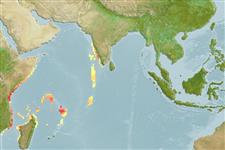>
Tetraodontiformes (Puffers and filefishes) >
Triacanthodidae (Spikefishes) > Triacanthodinae
Etymology: Bathyphylax: Greek, bathys = deep + Greek, phylax, -akos = wardn, keeper (Ref. 45335).
Environment: milieu / climate zone / depth range / distribution range
पारिस्थितिकी
समुद्री बाथीड़िमरसल; गहराई सीमा ? - 291 m (Ref. 58018). Deep-water
Indian Ocean: off Kenya (Ref. 6660). Northwest Pacific: Japan (first record) (Ref. 124779).
आकार / वज़न / Age
Maturity: Lm ? range ? - ? cm
Max length : 9.4 cm SL पुल्लिंग / अलिंग; (Ref. 97685)
Short description
आकृति विज्ञान | मौरफोमैटरिक्स
पृष्ठीय रीढ़ (सम्पूर्ण): 6; पृष्ठीय सौफट रेज़ (सम्पूर्ण): 14; ऐनल सौफट रेज़: 12; जानवरों की रीड़ का जोड़: 20. This species is distinguished by the color pattern of the body with upper half pinkish, 3 longitudinal distinct red stripes ( first originating around nape to base of spiny dorsal fin to origin of soft dorsal fin, second from just behind postero-dorsal edge of orbit and along side of body to end of soft dorsal-fin base, and the third starting just behind posterior edge of orbit, running on mid body, curving very slightly down below thrid dorsal-fin spine and ending just above posterior part of anal-fin base with a short disconnection below anterior part of soft dorsal fin); snout shorter than rest of head, dorsal profile of the snout slightly concave or relatively straight (Ref. 124779).
Life cycle and mating behavior
परिपक्व अवधि | पुनरुत्पत्ति | मछलीऔ का अंडे देना | अंडे | Fecundity | लार्वा
Tyler, J.C., 1986. Triacanthodidae. p. 887-890. In M.M. Smith and P.C. Heemstra (eds.) Smiths' sea fishes. Springer-Verlag, Berlin. (Ref. 6660)
IUCN Red List Status (Ref. 130435)
Threat to humans
Harmless
Human uses
अधिक जानकारी
आम नामउपशब्दचपायचयपरभक्षीईकोटोकसीकोलौजीपुनरुत्पत्तिपरिपक्व अवधिमछलीऔ का अंडे देनाSpawning aggregationFecundityअंडेEgg development
Age/Sizeबाढ़Length-weightLength-lengthLength-frequenciesमौरफोमैटरिक्सआकृति विज्ञानलार्वालारवल गतिकीभर्तीबहुतायतBRUVS
संदर्भजलीयकृषिजलीयकृषि रूपरेखाखींचआनुवंशिकीElectrophoresesहैरेटिबिलटीबीमारीप्रक्रमणNutrientsMass conversion
सहयोगीयोतस्वीरेStamps, Coins Misc.ध्वनिसिगुयटिरारफ्तारतैरने के प्रकारगिल क्षेत्रOtolithsदिमागदृष्टि
साधन
Special reports
Download XML
इंटरनेट स्रोत
Estimates based on models
Preferred temperature (Ref.
123201): 11.8 - 18.4, mean 13.4 °C (based on 12 cells).
Phylogenetic diversity index (Ref.
82804): PD
50 = 0.6250 [Uniqueness, from 0.5 = low to 2.0 = high].
Bayesian length-weight: a=0.01995 (0.00906 - 0.04395), b=3.01 (2.83 - 3.19), in cm total length, based on all LWR estimates for this body shape (Ref.
93245).
Trophic level (Ref.
69278): 4.1 ±0.8 se; based on size and trophs of closest relatives
Fishing Vulnerability (Ref.
59153): Low vulnerability (10 of 100).
